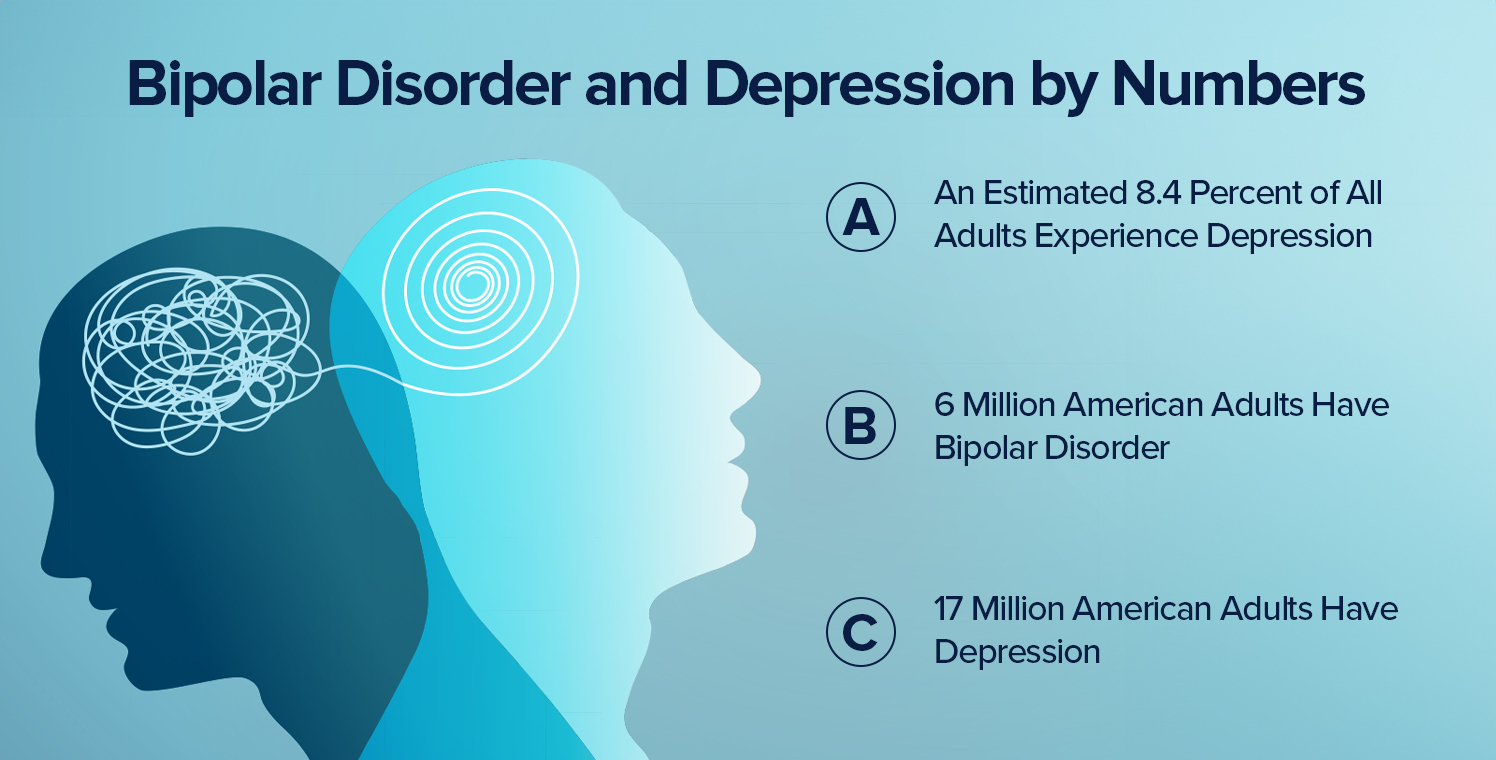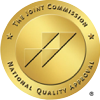Bipolar Disorder vs. Depression: Understanding the Differences
- Home
- Blog
- Bipolar Disorder
- Bipolar Disorder vs. Depression: Understanding the Differences
Imagine waking up one day feeling on top of the world. You’re so energized that you could tackle anything. A few days later, everything shifts. You find yourself in a state so low that even getting out of bed feels like an impossible task.
Now, consider this cycle repeating itself over and over. Is this depression or something more complex like bipolar disorder? Millions of people grapple with these very questions, unsure of what their symptoms signify. Though these conditions share similarities, certain key differences make them distinct. Hence, understanding the differences between bipolar disorder vs. depression can help you identify the symptoms and seek treatment immediately.
What Is Depression?
Depression is a mood disorder that affects how you feel, think, and handle daily activities. It’s more than just feeling sad or “down in the dumps.” Depression comes in different forms and can last for weeks, months, or even years if untreated.
Further, depression, or major depressive disorder (MDD), can lead to a variety of emotional and physical problems. As a result, individuals dealing with depression often feel detached from their daily lives. They may not experience the typical ebb and flow of emotions. This happens without truly engaging or connecting with their feelings. According to data from the National Comorbidity Survey (NSC), an estimated 8.4 percent of all adults experience depression.
The APA also highlights that depression is three times more prevalent among individuals aged 18-29 than those above 60. Therefore, while everyone feels down or sad from time to time, depression is entirely different. It involves persistent sadness, hopelessness, and a lack of interest in once-used activities.
What Is Bipolar Disorder?
The bi- in bipolar means “two” as it has two cycles: mania and depression. Hence, bipolar disorder is characterized by phases of emotional highs (mania or hypomania) and lows (depression). It’s not just a change in mood; it’s a shift in energy levels, behavior, and sleep patterns. The key differentiator between bipolar disorder vs. depression is the presence of hypomanic episodes, which are absent in unipolar depression.
Around 6 million American adults have bipolar disorder, which might seem like a large number. However, bipolar disorder is less common than depression, affecting over 17 million American adults annually. Although bipolar depression is a permanent condition, its symptoms can be managed with proper treatment.
Mood swings in bipolar disorder are treated through medication and psychotherapy by experienced mental health experts.

The exact causes of bipolar disorder remain unknown to date; however, it may involve a chemical brain imbalance. Experts claim this disorder to be associated with certain genetic factors since it frequently occurs within families.
Types of depression and bipolar disorder
-
Types of depression
Depression isn’t a one-size-fits-all diagnosis. You might suffer from:
-
Major Depressive Disorder (MDD)
Characterized by long-term, continuous depression without manic phases.
-
Persistent Depressive Disorder (Dysthymia)
Chronic depression that lasts for at least two years but may not be as severe as MDD.
-
Postpartum Depression
Occurs in women after childbirth, marked by feelings of extreme sadness, exhaustion, and anxiety.
-
MDD with Seasonal Pattern
Seasonal Depression is triggered by seasonal changes, typically during the winter months.
-
Types of bipolar disorder
Bipolar disorder has a few different forms, including:
-
Bipolar I Disorder
Bipolar I Disorder involves severe manic episodes that last at least a week and often require hospitalization, alternating with periods of depression.
- Bipolar II Disorder
Bipolar II Disorder is characterized by less severe hypomanic episodes, which are accompanied by longer-lasting depressive episodes.
-
Cyclothymic Disorder
Cyclothymic Disorder is a milder form of bipolar disorder, characterized by frequent mood swings that are not as extreme as those found in Bipolar I or II.
Common Symptoms of depression and bipolar disorder
Symptoms of depression and bipolar disorder vary to a great extent. Read below to unravel the unique symptoms of both.
-
Symptoms of depression
Depression manifests through a variety of symptoms that include:
a.) Constant sadness or hopelessness
b.) Loss of interest in activities once enjoyed
c.) Fatigue or lack of energy
d.) Changes in appetite or sleep patterns
e.) Difficulty concentrating
f.) Thoughts of death or suicide
g.) Pessimism and restlessness
h.) Headaches following insomnia.
-
Symptoms of bipolar disorder
Bipolar disorder’s prime feature is the presence of manic or hypomanic episodes alongside depressive periods. Symptoms of mania or hypomania may include:
a.) Manic Symptoms: Increased energy, reduced need for sleep, racing thoughts, impulsive behaviors, and feeling overly happy or “high.”
b.) Depressive Symptoms: Similar to those found in depression, including sadness, lack of energy, euphoric mood, and feelings of worthlessness.
c.) Hypomanic Symptoms: Less severe manic symptoms, though they can still disrupt your life. These include unrealistic thinking, fast speech, and impulsive behavior.
The depressive episodes in bipolar disorder are similar to unipolar depression. However, it may also involve additional features such as psychomotor retardation, hypersomnia, or psychosis.
Risk factors for depression and bipolar disorder
Depression can affect anyone. Your risk increases with serious illness or family history. Environmental and psychological factors can also raise your risk. Additionally, the exact cause of bipolar disorder is unknown. However, family history increases your likelihood. Symptoms often appear in adolescence, early adulthood, or later in life.
Bipolar disorder increases your risk of:
– Substance abuse
– Heart disease
– Migraines
– Other illnesses
People with bipolar disorder may suffer from:
– PTSD
– Social Phobia
– Anxiety Disorder
– ADHD
How to Diagnose Bipolar Depression?
Diagnosing bipolar depression involves evaluating mood swings, energy levels, and behavior patterns. Doctors perform a thorough assessment, including physical exams and interviews. They may ask about family history, sleep patterns, and emotional highs and lows.
For those wondering how to diagnose bipolar depression, mental health professionals use specific diagnostic tools like the DSM-5 criteria. They also rule out other conditions through lab tests or medical history.
Bipolar disorder can sometimes be misdiagnosed as depression, especially if manic episodes have not yet occurred. This underscores the importance of accurately tracking mood patterns to distinguish between the two conditions.
Treatment of bipolar disorder and depression
-
Treatment for depression
Treatment for depression often includes a combination of medication and therapy. Antidepressants, such as SSRIs or SNRIs, help regulate mood. Also, cognitive-behavioral therapy (CBT) helps to manage thoughts and feelings. When cases are severe, electroconvulsive therapy is used for treatment.
-
Treatment for bipolar disorder
The treatment of bipolar disorder differs significantly. For bipolar disorder, mood stabilizers like lithium or anticonvulsants are often prescribed to manage the manic phases. Antipsychotics may also be used but are usually paired with mood stabilizers to avoid triggering manic episodes. Therapy, such as CBT or psychoeducation, helps manage symptoms and prevent relapse.
Decoding Ultimate Difference: Depression vs. Bipolar Disorder
While bipolar disorder and depression share similarities, several key differences distinguish these conditions:
- The primary difference is the presence of manic or hypomanic episodes in bipolar disorder, absent in depression.
- Individuals with bipolar disorder experience alternating periods of depression and mania/hypomania, while depression only involves depressive episodes.
- Mania and hypomania, characterized by irritable mood, increased energy, and less need for sleep, occur only in bipolar disorder.
- Bipolar disorder typically has more frequent mood episodes than depression, with shorter depressive episodes.
For expert care and support, contact Cast Treatment Centers, a renowned facility specializing in bipolar disorder treatment in Los Angeles.
Conclusion
Facing the challenges of bipolar disorder vs. depression can feel overwhelming. Hence, understanding the distinctions between these two conditions can make all the difference in getting the right diagnosis and treatment. While both of these overlapping symptoms, knowing how to identify their unique symptoms, risks, and treatments can help you regain control. If you’re seeking support, Cast Treatment Centers provide comprehensive mental health treatment in Los Angeles tailored to your specific needs. We offer compassionate, expert care to help you regain balance and well-being. So, take the next step toward a healthier mental state and improve your quality of life.
GET STARTED TODAY!
424-302-2598
CAST Treatment Centers is Proud to Celebrate Over 18 Years
Helping Individuals & Families
Programs
What We Treat
-
Substance Abuse
Insurance
Alumni
Contact Cast Treatment Centers
CAST Treatment Centers
630 N Doheny Drive
West Hollywood, CA 90069
424-302-2598
Email
Administration
632 N Doheny Drive
West Hollywood, CA 90069
424-302-2598
Email
Service Area
CAST Treatment Centers is licensed by the California State Department of Health Care Services. DHCS Certification for Intensive Outpatient and Outpatient Services.
License Number: 190936BP.
Expiration Date: 8/31/2025.
Copyright © 2022 CAST Treatment Centers. All rights reserved.
Privacy Policy | HIPAA | Terms of Use | Site Map


